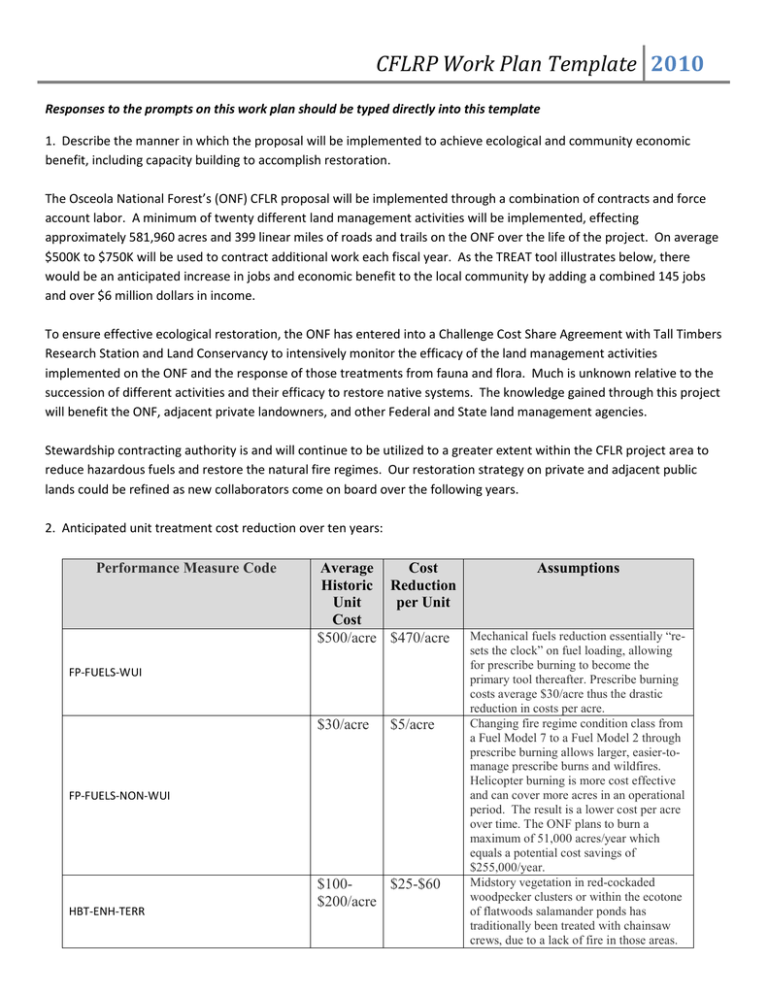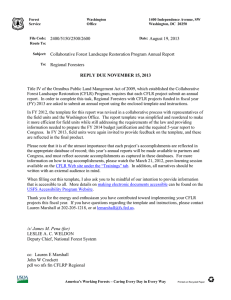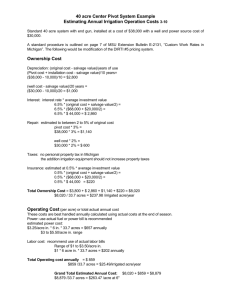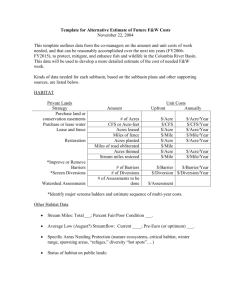CFLRP Work Plan Template 2010
advertisement

CFLRP Work Plan Template 2010 Responses to the prompts on this work plan should be typed directly into this template 1. Describe the manner in which the proposal will be implemented to achieve ecological and community economic benefit, including capacity building to accomplish restoration. The Osceola National Forest’s (ONF) CFLR proposal will be implemented through a combination of contracts and force account labor. A minimum of twenty different land management activities will be implemented, effecting approximately 581,960 acres and 399 linear miles of roads and trails on the ONF over the life of the project. On average $500K to $750K will be used to contract additional work each fiscal year. As the TREAT tool illustrates below, there would be an anticipated increase in jobs and economic benefit to the local community by adding a combined 145 jobs and over $6 million dollars in income. To ensure effective ecological restoration, the ONF has entered into a Challenge Cost Share Agreement with Tall Timbers Research Station and Land Conservancy to intensively monitor the efficacy of the land management activities implemented on the ONF and the response of those treatments from fauna and flora. Much is unknown relative to the succession of different activities and their efficacy to restore native systems. The knowledge gained through this project will benefit the ONF, adjacent private landowners, and other Federal and State land management agencies. Stewardship contracting authority is and will continue to be utilized to a greater extent within the CFLR project area to reduce hazardous fuels and restore the natural fire regimes. Our restoration strategy on private and adjacent public lands could be refined as new collaborators come on board over the following years. 2. Anticipated unit treatment cost reduction over ten years: Performance Measure Code Average Cost Assumptions Historic Reduction Unit per Unit Cost $500/acre $470/acre Mechanical fuels reduction essentially “re- FP-FUELS-WUI $30/acre $5/acre FP-FUELS-NON-WUI HBT-ENH-TERR $100$25-$60 $200/acre sets the clock” on fuel loading, allowing for prescribe burning to become the primary tool thereafter. Prescribe burning costs average $30/acre thus the drastic reduction in costs per acre. Changing fire regime condition class from a Fuel Model 7 to a Fuel Model 2 through prescribe burning allows larger, easier-tomanage prescribe burns and wildfires. Helicopter burning is more cost effective and can cover more acres in an operational period. The result is a lower cost per acre over time. The ONF plans to burn a maximum of 51,000 acres/year which equals a potential cost savings of $255,000/year. Midstory vegetation in red-cockaded woodpecker clusters or within the ecotone of flatwoods salamander ponds has traditionally been treated with chainsaw crews, due to a lack of fire in those areas. CFLRP Work Plan Template 2010 $90$65$125/acre $100/acre FOR-VEG-IMP Once these areas are treated within the project it is expected that fire would serve as the primary management tool, or at a minimum a bush-hog could maintain the areas at a reduced cost per acre. Light, roller-drum chopping is integral to reducing palmetto/shrubs to advance ground cover restoration in combination with prescribe burning. It is anticipated that after the light, roller-drum chopping has been applied within the project area, prescribe burning will become the primary means of ground cover maintenance. 3. Anticipated costs for infrastructure needed to implement project: Type of Infrastructure No infrastructure is anticipated at this time. Anticipated Cost $0 Funding Source (federal, private, etc) N/A 4. Projected sustainability of the supply of woody biomass and small diameter trees removed in ecological restoration treatments: Fiscal Year 2010 2011 2012 2013 2014 2015 2016 2017 2018 2019 *There Number of acres to be treated 192 322 350 393 500 500 500 500 500 500 Projected Green Tons Removed per Acre 0* 0* 4 4.5 5 5 6 6 7 7 Total Green Tons Available 0 0 1,400 1,768 2,500 2,500 3,000 3,000 3,500 3,500 was no biomass available in FY10 as there was no time to implement a new timber sale to include a biomass component in late August 2010. For FY11, there are no current markets on-line; however we are seeking out opportunities and other markets to take advantage of an anticipated biomass component in 2012. Two biomass facilities have been permitted within an operable range of our CFLRA project on the ONF and should be operational within two to three years. CFLRP Work Plan Template 2010 5. Projected local economic benefits: Type of projects Commercial Forest Products Other Project Activities TOTALS: Total direct jobs 24.5 47.5 72.1 Total indirect jobs 64.5 8.6 73.1 Total Direct Labor Income $1,873,699 $1,096,072 $2,969,770 Total Indirect Labor Income 1 $2,784,490 $352,357 $3,136,846 The TREAT tool was also run to include CFLR Heritage Survey contracts. The results were an increase of one direct and one indirect additional job and an increase of a combined $129,000 in direct and indirect labor. If not for additional CFLR activities, these jobs would not exist and should be noted. 6. Document the non-Federal investment in the priority landscape: Source of Investment Tall Timbers Research Station and Land Conservancy Amount of Investment $930,000 National Wild Turkey Federation $50,000 Southeast Regional $1,029,600 Partnership for Planning and Sustainability (SERPPAS) Description of Use TTRS has entered into a Challenge Cost Share Agreement with the NFs in Florida for third-party monitoring. Their In-Kind matching is approximately $93K/year for ten years. Through the NWTF’s Superfund Program, the ONF would receive $5K/year for 10 years to improve/restore T&E and nonT&E habitat. SERPPAS funds the monitoring and translocation of the Federally listed redcockaded woodpecker on the ONF. Their monitoring efforts within the CFLR project areas will be critical to ensure the correct timing and scale of CFLR activities. 7. Plans to decommission any temporary roads established to carry out the proposal: Projected accomplishment year (fiscal) 2010 2011 2012 2013 2014 2015 2016 2017 2018 1 Number of Miles to be Decommissioned* N/A N/A N/A N/A N/A N/A N/A N/A N/A Values obtained from Treatment for Restoration Economic Analysis Tool (TREAT) spreadsheet, “Impacts-Jobs and Income” tab. Spreadsheet available at INSERT WEBSITE HERE CFLRP Work Plan Template 2010 2019 N/A *The ONF does not anticipate creating any temporary roads to carry out the proposal, however the proposal has identified 399 miles of roads and trails that will be decommissioned to improve watershed condition, reduce erosion and sedimentation, and decrease fragmentation of wildlife habitat.







